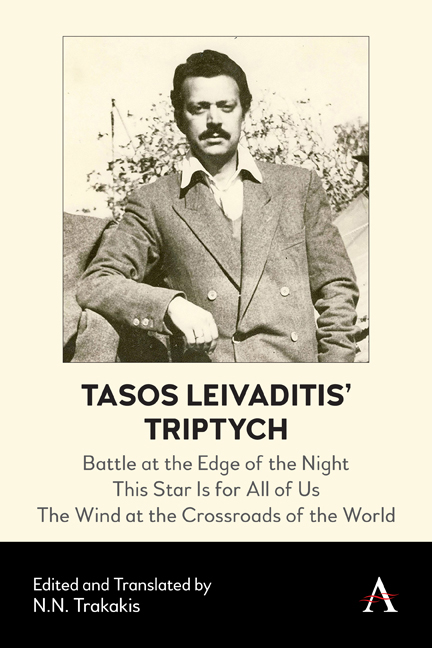 Tasos Leivaditis' Triptych
Tasos Leivaditis' Triptych Introduction
Published online by Cambridge University Press: 15 September 2022
Summary
Tasos Leivaditis came to prominence in 1952–53 with his first three poetry books, presented here in translation as a ‘triptych’, seeing as all three arose from and address similar experiences in war-ravaged Greece. By this time Leivaditis’ youth was over (he was 30 years of age when the first of the three books came out in 1952), and any inexperience or naivete was also long gone, driven away by the winds of terror and torture which scarred the bodies (both physical and literary) of all leftist intellectuals of that generation. After the publication of his third book, in late 1952, Leivaditis was hailed by the left, in both Greece and abroad, as one of the greatest new talents to have appeared in recent years, and at the same time he was being persecuted and imprisoned by the police state – a polarity in the reception of Leivaditis’ work that mirrored the deep divisions in Greece and Europe at large in the early Cold War years.
While the Cold War is only of historical interest today, Leivaditis’ triptych continues to be widely read and loved: it is not unusual for lines or passages to be recited by heart, or set to music in popular festivals, or spraypainted on walls in Athens. Even commentators and critics, until fairly recently, tended to concentrate on Leivaditis’ early and more ‘political’ writings, commonly drawing a sharp line between these writings and those that followed after Leivaditis’ so-called political deconversion. But if we are to better understand Leivaditis’ early work, and in particular his first three works, we need to delve into the context, both biographical and sociohistorical, out of which they emerged. This is what I shall attempt here, beginning with the bright and youthful Leivaditis and his relatively unknown first forays into the world of letters.
Days of Youth
Leivaditis was born in Athens on 20 April 1922, on the eve of Easter Sunday, which is in part why he was given the name ‘Tasos’ (short for ‘Anastasios’, derived from the Greek word for ‘resurrection’).
- Type
- Chapter
- Information
- Tasos Leivaditis' TriptychBattle at the Edge of the Night', 'This Star Is for All of Us', 'The Wind at the Crossroads of the World', pp. 1 - 40Publisher: Anthem PressPrint publication year: 2022


